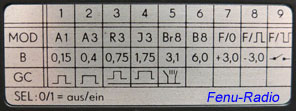|
It is big; it is heavy and built like a tank. We are talking about the EKD 500. This radio was built by "Funkwerke Köpenick" near Berlin around 1986. At that time, there still was the DDR, the German Democratic Republic. At Funkwerke Köpenick, receivers were built which are still in use and which many shortwave listeners rave about. The EKD 500, just like its predecessor EKD 300, was widely used by radio services, mainly by the military. It certainly played a big role during the Cold War. However, the EKD 500 was also used by marine radio services and other civil agencies.
In contrast to its predecessor, the EKD 500 could be remotely controlled with a computer. It was designed this way. It had, however, a disadvantage: A normal frequency selection like with the EKD 300 was not possible anymore. The EKD 500 only had an inconspicuous small rotary knob which stopped with quite some noise. Additionally, there were signal drop-outs caused by noise. After manual tuning for ten minutes, your hands were hurting. A real grind. This could only be remedied by two easy modifications. The scanning mechanism could easily be removed and in order to get rid of the noise drop-outs during the tuning, a resistor had to be replaced by another one on the control unit. That is rather easy to do, if you have some knowledge of electronics. However, only the 10 Hz and 100Hz tuning steps are without noise drop-outs. They are still noticeable when using tuning steps about 1KHz, but not as extreme anymore. I made these modifications myself and also installed a bigger tuning knob. Now the EKD 500 was ready for reception.
During the few weeks that I had the EKD 500, I compared it with all receivers which were at my disposal at that time. Starting from Long wave to the 10m-band, the EKD showed very good signal quality with steady sensitivity and little noise. The manual gain control (MGC) turned out to be the best choice. The automatic gain control (AGC) could not convince me. The decay time way too short. The noise during the speech pauses increased considerably. Comparisons with common semiprofessional receivers, e.g., AOR AR7030, JRC NRD-525 etc showed how good the speech intelligibilty of the EKD 500 is. It proved to be better most of the time. The audio is nothing for audiophiles, stresses the pitch and has practically no bass. The intelligibility is also enhanced by the excellent mechanical and highly selective filters. A big help is also the very stable synchronic detector which synchronizes the signals in the ECSS- mode and optimizes the suppression of the noise and the crackling. Even the sidebands are selectable. But there are also negative aspects which should be mentioned. The EKD 500 is a professional receiver which was developed for large antennas. These antennas offer so much signal strength that the sensitivity of the receiver was a minor problem. When we connected such a receiver to one of the antennas mostly used by SWLs, e.g., a 20m long wire or a ALA1530+, we were not surprised when the EKD 500 became more and more deaf under a certain signal strength. This happened because hobby antennas simply do not have enough strength. This is the EKD's 500 weakest point. Just like many other professional receivers, the EKD 500 does not offer any help for optimizing the signal. You will look in vain for noise blankers, notch filters or passband tuning. The EKD has been in use for a considerable time. Although these receivers are built extremely robust and seem as if they would work for ever, you should think twice if such a boat anchor with its considerable weight on you desk is the right radio for you. Unfortunately, even the EKD 500 will break down and can cause huge repair bills. Only the shipping a 25Kg radio is not exactly cheap. There are still enough spare parts available. Some technician are specialized for these receivers and can help if problems occur. In the pictures, you can also see the additional EZ 100. This is a preselector and has a demodulator for RTTY. It is of no use for the SWLs. Conclusions: A huge and heavy shortwave receiver Made in Germany. It offers very good reception with suitable (large) antennas. It is excellent as far as speech intelligibility is concerned. In any case, SWLs should modify the tuning knob A big "Thank you" to Reinhold Schuttkowski for loaning me his EKD 500. Written at 08.11.2014
|


.jpg)
.jpg)
.jpg)

.jpg)